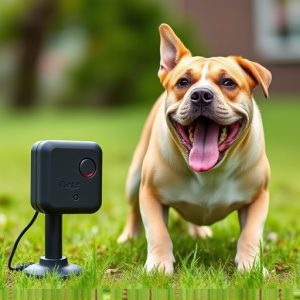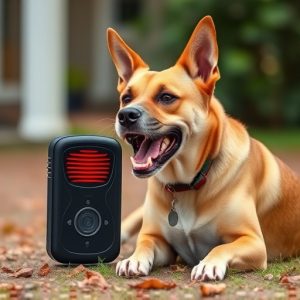Adjusting Sonic Repellent Training Levels: Effective Dog Behavior Modification
Ultrasonic behavior modifiers, using high-frequency sound waves invisible to humans but felt by dogs…….
Ultrasonic behavior modifiers, using high-frequency sound waves invisible to humans but felt by dogs, offer a humane and effective way to train dogs. By carefully adjusting the adjusting sonic repellent training levels, owners can condition their pets to respond positively while avoiding unwanted behaviors like barking, jumping or chewing. This technology is versatile, safe when used correctly (starting at lower intensities and monitoring dog reactions), and promotes positive reinforcement for optimal learning.
“Unleash your dog’s best behavior with the power of ultrasonic training! This innovative approach, employing non-aggressive methods, offers a quiet and effective solution to common canine issues. Our article delves into the science behind ultrasonic behavior modifiers, exploring how these devices use specific frequencies to guide your pet’s actions. We’ll dissect the critical factors in adjusting sonic repellent training levels for optimal results. From understanding unwanted behaviors to ensuring safety, this guide is your comprehensive resource for harnessing the benefits of ultrasonic dog training.”
- Understanding Ultrasonic Behavior Modifiers: A Non-Aggressive Approach
- How Dog Training Ultrasonic Devices Work: Adjusting the Frequency
- Setting Training Levels: Finding the Right Balance for Your Dog
- Common Applications: Managing Unwanted Behaviors with Ultrasonics
- Safety and Effectiveness Considerations for Sonic Repellents
Understanding Ultrasonic Behavior Modifiers: A Non-Aggressive Approach
Understanding Ultrasonic Behavior Modifiers is key when considering a non-aggressive approach to dog training. These devices emit high-frequency sound waves that are inaudible to humans but can capture a dog’s attention, effectively acting as a sonic repellent. By adjusting the training levels of these ultrasonic modulators, you can condition your dog to associate certain behaviors with the sound, reinforcing positive actions while deterring unwanted ones.
This method leverages the dog’s natural sensitivity to sounds without resorting to harsh or punitive measures. It’s crucial to select an appropriate frequency range that effectively reaches your dog but avoids potential harm to their sensitive hearing. Proper adjustment of training levels allows for gradual learning and reinforcement, making it a versatile tool for addressing various behavioral challenges in a humane and effective manner.
How Dog Training Ultrasonic Devices Work: Adjusting the Frequency
Dog training ultrasonic devices work by emitting a high-frequency sound that is inaudible to humans but can be heard and felt by canines. This sound acts as a sonic repellent, triggering a response from the dog. The device is designed to be safe and effective, with adjustable settings to cater to different training needs and canine personalities. By adjusting the sonic repellent training levels, owners can fine-tune the intensity of the ultrasonic signal, ensuring it remains consistent with their dog’s sensitivity and learning curve.
Changing the frequency involves manipulating the device’s control dial or buttons, which allows for a range of options from low to high decibel levels. Lower frequencies are generally used for gentle reminders while higher ones serve as more powerful deterrents. The key is finding the optimal setting that motivates your dog to change behavior without causing discomfort or stress. Regular practice and consistent use of these devices can significantly enhance training outcomes, making them valuable tools for canine educators and pet owners alike.
Setting Training Levels: Finding the Right Balance for Your Dog
When it comes to dog training with ultrasonic behavior modifiers, setting the right training levels is crucial for effective and positive results. These devices use high-frequency sound waves to gently encourage or discourage unwanted behaviors, making them a versatile tool for addressing various issues like barking, jumping, or pulling on leashes. However, adjusting the sonic repellent training levels is key to ensuring your dog doesn’t become stressed or desensitized. Start with the lowest setting and gradually increase it as needed, monitoring your dog’s reaction closely.
The balance you seek is between providing enough stimulus to correct the behavior and avoiding overstimulation that could lead to fear or aggression. It often requires patience and observation to find the sweet spot. Consider factors like your dog’s breed, age, and temperament when deciding on training intensity. Remember, consistent reinforcement of desired behaviors alongside the ultrasonic signal will help reinforce positive changes in your dog’s behavior.
Common Applications: Managing Unwanted Behaviors with Ultrasonics
In the realm of dog training, ultrasonic behavior modifiers have emerged as a game-changer for managing unwanted behaviors. These devices emit high-frequency sound waves that are inaudible to humans but can capture a dog’s attention and modify their actions. Common applications range from addressing barking issues to deterring destructive chewing or jumping on furniture. By adjusting the sonic repellent training levels, owners can effectively communicate with their pets without resorting to harsh methods.
This technology is particularly useful for addressing behaviors that traditional training techniques might struggle to overcome. For example, ultrasonic bark detectors can interrupt excessive barking without startling or causing distress to the dog. Similarly, chewer-specific ultrasonic devices emit sounds when a dog approaches prohibited items, reinforcing positive behavior choices and distracting them from destructive tendencies. Adjusting the intensity and frequency of these sounds allows for gradual training and precise correction, fostering a more harmonious living environment.
Safety and Effectiveness Considerations for Sonic Repellents
When using dog training ultrasonic behavior modifiers, safety and effectiveness should always be at the forefront of your considerations. These devices emit high-frequency sound waves that are inaudible to humans but can deter dogs from certain behaviors. However, it’s crucial to understand that not all dogs react equally to these repellents, and their effectiveness can vary based on factors like breed, age, and sensitivity to sound. Always consult with a professional trainer or veterinarian before introducing sonic repelent training to ensure its suitability for your dog’s unique temperament and needs.
Adjusting the sonic repellent training levels is an important aspect of responsible use. These devices typically offer different settings, from low to high intensity. Start with lower levels and gradually increase as needed. Monitoring your dog’s reaction closely during each session will help you determine the optimal setting for effective training without causing discomfort or stress. Remember, safety isn’t just about preventing harm; it also involves ensuring positive reinforcement techniques are prioritized, fostering a calm and positive learning environment for your furry friend.
Dog training ultrasonic behavior modifiers offer a modern, non-aggressive approach to managing unwanted behaviors. By adjusting sonic repellent training levels, you can effectively communicate with your dog without causing discomfort. Understanding how these devices work and selecting the right balance for your pet ensures safe and successful training. Remember, proper use of ultrasonic devices can revolutionize your dog’s behavior, creating a harmonious relationship based on positive reinforcement.


